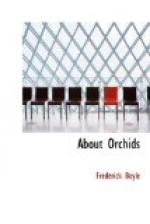As time went on, and the merits of C. labiata vera were understood, the few specimens extant—proceeding from Mr. Swainson’s importation—fetched larger and larger prices. Those merits, indeed, were conspicuous. Besides the season of flowering, this proved to be the strongest and most easily grown of Cattleyas. Its normal type was at least as charming as any, and it showed an extraordinary readiness to vary. Few, as has been said, were the plants in cultivation, but they gave three distinct varieties. Van Houtte shows us two in his admirable Flore des Serres; C. l. candida, from Syon House, pure white excepting the ochrous throat—which is invariable—and C. l. picta, deep red, from the collection of J.J. Blandy, Esq., Reading. The third was C. l. Pescatorei, white, with a deep red blotch upon the lip, formerly owned by Messrs. Rouget-Chauvier, of Paris, now by the Duc de Massa.
Under such circumstances the dealers began to stir in earnest. From the first, indeed, the more enterprising had made efforts to import a plant which, as they supposed, must be a common weed at Rio, since men used it to “pack” boxes. But that this was an error they soon perceived. Taking the town as a centre, collectors pushed out on all sides. Probably there is not one of the large dealers, in England or the Continent, dead or living, who has not spent money—a large sum, too—in searching for C. l. vera. Probably, also, not one has lost by the speculation, though never a sign nor a hint, scarcely a rumour, of the thing sought rewarded them. For all secured new orchids, new bulbs—Eucharis in especial—Dipladenias, Bromeliaceae, Calladiums, Marantas, Aristolochias, and what not. In this manner the lost orchid has done immense service to botany and to mankind. One may say that the hunt lasted seventy years, and led collectors to strike a path through almost every province of Brazil—almost, for there are still vast regions unexplored. A man might start,




